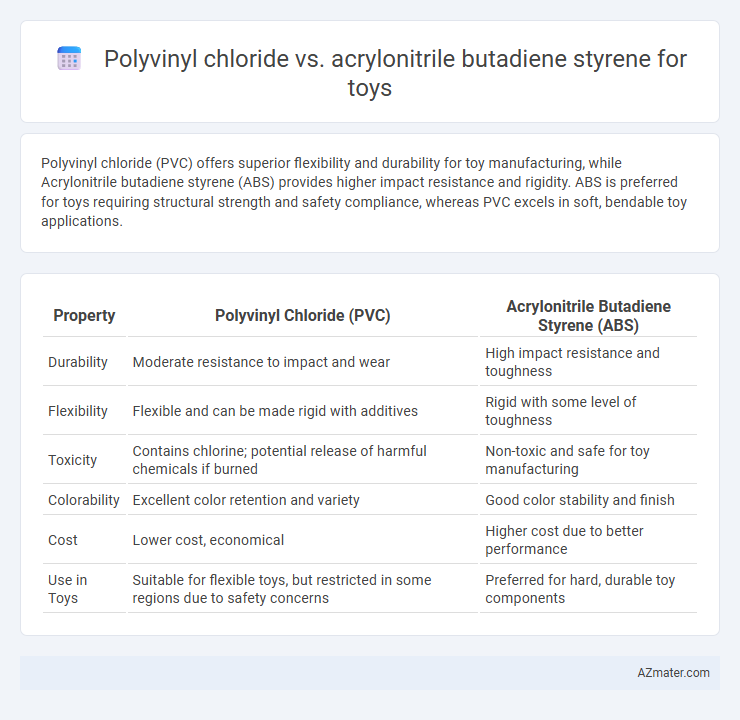Polyvinyl chloride (PVC) offers superior flexibility and durability for toy manufacturing, while Acrylonitrile butadiene styrene (ABS) provides higher impact resistance and rigidity. ABS is preferred for toys requiring structural strength and safety compliance, whereas PVC excels in soft, bendable toy applications.
Table of Comparison
| Property | Polyvinyl Chloride (PVC) | Acrylonitrile Butadiene Styrene (ABS) |
|---|---|---|
| Durability | Moderate resistance to impact and wear | High impact resistance and toughness |
| Flexibility | Flexible and can be made rigid with additives | Rigid with some level of toughness |
| Toxicity | Contains chlorine; potential release of harmful chemicals if burned | Non-toxic and safe for toy manufacturing |
| Colorability | Excellent color retention and variety | Good color stability and finish |
| Cost | Lower cost, economical | Higher cost due to better performance |
| Use in Toys | Suitable for flexible toys, but restricted in some regions due to safety concerns | Preferred for hard, durable toy components |
Introduction to Toy-Grade Plastics: PVC vs. ABS
Toy-grade plastics prioritize safety, durability, and ease of molding, making Polyvinyl Chloride (PVC) and Acrylonitrile Butadiene Styrene (ABS) prominent choices in the industry. PVC offers flexibility and chemical resistance, ideal for soft, colorful toys, while ABS provides superior impact resistance and rigidity, suitable for structural components and detailed designs. Both materials meet stringent safety standards but differ significantly in texture, environmental impact, and application scope within toy manufacturing.
Chemical Composition Differences
Polyvinyl chloride (PVC) is a synthetic plastic polymer made from vinyl chloride monomers, notable for its rigidity or flexibility based on added plasticizers, and contains chlorine atoms that contribute to its chemical resistance and flame retardancy. Acrylonitrile butadiene styrene (ABS) is a terpolymer composed of acrylonitrile, butadiene, and styrene, offering toughness, impact resistance, and a smooth surface finish due to its distinct molecular structure combining rigidity and rubber-like properties. The chlorine presence in PVC contrasts with the hydrocarbon-based components of ABS, influencing their chemical durability, toxicity, and environmental impact in toy applications.
Mechanical Strength and Impact Resistance
Polyvinyl chloride (PVC) offers excellent mechanical strength with good rigidity and durability, making it suitable for toys requiring firm structural integrity. Acrylonitrile butadiene styrene (ABS) surpasses PVC in impact resistance due to its tough and resilient polymer blend, providing superior shock absorption and resistance to wear. ABS is often favored for toys that endure rough handling, while PVC is chosen for applications demanding stiffer components.
Safety and Toxicity Concerns
Polyvinyl chloride (PVC) and Acrylonitrile Butadiene Styrene (ABS) both serve as common materials in toy manufacturing, but safety and toxicity concerns vary significantly between them. PVC can release harmful chemicals such as phthalates and chlorine-based compounds, raising potential risks of endocrine disruption and respiratory issues in children. ABS, known for its durability and non-toxic properties, generally poses fewer health risks, making it a safer choice in toys intended for young children and frequent handling.
Colorability and Surface Finish
Polyvinyl chloride (PVC) offers excellent colorability due to its affinity for dyes and pigments, enabling vibrant and diverse toy designs, while maintaining a smooth, glossy surface finish that enhances visual appeal. Acrylonitrile butadiene styrene (ABS) provides superior surface finish with a high-quality matte or glossy texture, but its colorability is somewhat limited compared to PVC, often requiring masterbatch pigments or painting for vivid coloration. Both materials are widely used in toy manufacturing, with PVC favored for intricate coloration and ABS preferred for durable, high-quality surface aesthetics.
Ease of Manufacturing and Processing
Polyvinyl chloride (PVC) offers superior ease of manufacturing for toys due to its excellent moldability and compatibility with various plasticizers, enabling smooth extrusion and injection molding processes. Acrylonitrile butadiene styrene (ABS) also provides good processability with faster cycle times and better dimensional stability, making it ideal for intricate toy designs. However, PVC's flexibility allows easier post-processing modifications, while ABS delivers enhanced surface finish with less finishing effort.
Cost Comparison for Toy Production
Polyvinyl chloride (PVC) is generally less expensive than acrylonitrile butadiene styrene (ABS), making it a cost-effective choice for toy production where budget constraints are critical. PVC offers advantages in flexibility and durability at a lower price point, whereas ABS, though costlier, provides superior impact resistance and a higher-quality finish. Manufacturers often weigh the initial material cost of PVC against the longer-term benefits and perceived value of ABS in premium toy lines.
Durability and Lifespan in Toys
Polyvinyl chloride (PVC) exhibits high chemical resistance and flexibility, contributing to its durability in toys subjected to frequent handling and bending. Acrylonitrile butadiene styrene (ABS) demonstrates superior impact resistance and rigidity, making it ideal for toys requiring structural strength and long-term resilience. The lifespan of PVC toys may be shortened by plasticizer migration, while ABS toys maintain consistent mechanical properties, ensuring prolonged durability under stress.
Environmental Impact and Recycling
Polyvinyl chloride (PVC) used in toys poses significant environmental challenges due to its production involving hazardous chlorine compounds and the release of dioxins during incineration, complicating recycling efforts. Acrylonitrile butadiene styrene (ABS) offers a more eco-friendly profile, as it is easier to recycle and does not release toxic substances during disposal, though it is derived from petroleum-based sources. Choosing ABS over PVC in toy manufacturing reduces long-term environmental impact and enhances recycling potential, supporting sustainability in the toy industry.
Industry Recommendations and Use Cases
Polyvinyl chloride (PVC) is favored in toy manufacturing for its flexibility, durability, and cost-effectiveness, making it ideal for soft toys, inflatable playsets, and waterproof components. Acrylonitrile butadiene styrene (ABS) is recommended for toys requiring high impact resistance, rigidity, and excellent surface finish, often used in construction sets, action figures, and electronic toy housings. Industry standards such as ASTM F963 emphasize safety and non-toxicity, guiding manufacturers to select PVC or ABS based on the toy's mechanical demands and regulatory compliance.

Infographic: Polyvinyl chloride vs Acrylonitrile butadiene styrene for Toy
 azmater.com
azmater.com